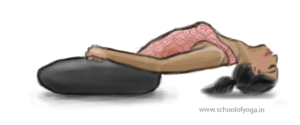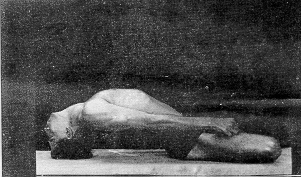What is matsyāsana (fish pose)
Matsyāsana is a mandatory āsana that is performed after halāsana and sarvāsana to reverse the spinal pressure on the neck. Matsyāsana is an advanced āsana and must be learned under the guidance of an expert.
How does one perform matsyāsana? (should be learned under supervision)

- Sthithi (starting) position: First, sit in Padmāsana.
- Second, using elbows as support, slowly fall backwards on the back until you are completely on the ground.
- Third, take hands rearward and place them under the shoulder.
- Then, using hands, lift shoulders off the ground while bending head backwards towards the body till the neck is completely stretched and the body is balanced on the top of the head.
- Slowly, release the load on the hands and transfer weight of the torso on the head. Ensure that the body is in balance and there is no strain on the head or neck.
- Now, take hands forward to grip toes. Importantly, pull on the toes so that the legs, back and neck are in tension. This is a reverse neck lock or matsya-banda.
- Maintain position for around 10 seconds. Remember to maintain shallow breathing.
- Next, release hands and bring to side. Slowly, straighten legs, stretch body and relax.
- The dṛṣṭi (gaze) recommended is ūrdhva-dṛṣṭi (open sky gaze).
What are the benefits of matsyāsana?
- Firstly, the reverse neck lock reverses and compensates for pressure created by the neck lock created by sarvangasana and halasana. So, halāsana should always be followed by sarvangāsana and finally by matyāsana.
- Importantly, this exercise is good for toning the neck, shoulders muscles, upper, middle and lower back. Additionally, this exercise stretches the chest and abdominal muscles thereby toning them.
- Also, matsāsana increases blood supply to the brain stem and the movement increases its suppleness. The complex and sensitive muscles of the neck and head are exercised and rejuvenated.
- Lastly, matsyāsana is good for stabilising irregularities in periods for women.
What are the possible matsyāsana contraindications?
 Firstly, if you have any form of back ache, do not attempt this āsana without expert supervision and support.
Firstly, if you have any form of back ache, do not attempt this āsana without expert supervision and support.- Importantly, matsyāsana should not to be done by people having neck ailments like cervical spondylitis.
- Also, those with cardiac problems such as high blood pressure should start this exercise only after getting proficiency in other āsana and that too, increase intensity of practice gradually, under guidance of a doctor.
- Additionally, do not perform this āsana if you have cervical spondylosis, hernia or arthritis.
- Finally, people with kidney ailments, hernia etc should avoid this āsana.
- Lastly, this āsana should not be practiced during menstruation and pregnancy.
Some noteworthy points on matsyāsana.
Internal Links: Dharma (conditioning), Stress and Situational Awareness, Prana, Asana sequence, Asana schedule, Asana Focus or gazing, Pranayama, Hatha Yoga Pradeepika
External Links: Prana, Chakra, Pancha Tattva, Pancha Prana, Pancha Kosha, Nadi,
- Importantly, the pulling of the feet increases the lumbar arch and rejuvenated the sympathetic and para-sympathetic nervous system.
- Also, the pulling of the feet also increases flexibility of the knees and improves ability to perform padmasana.
- However, be very careful when increasing pressure on the neck muscles. In fact, a jerk or improperly balanced pull could easily result in muscle or ligament damage in the neck and this can be very painful.